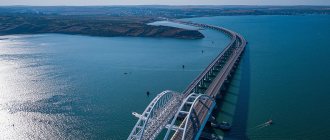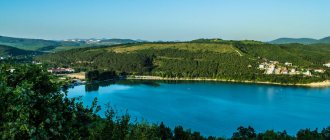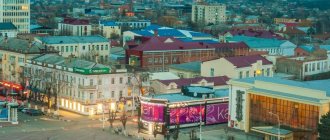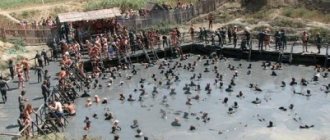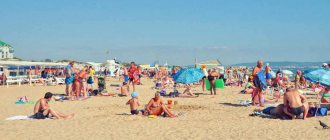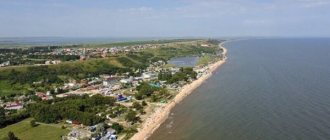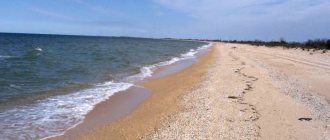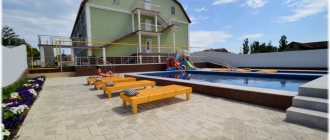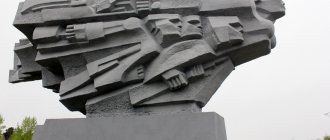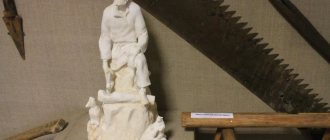In addition to the beautiful picturesque natural monuments for which the South of Russia is so famous, man-made ones, covered in legends and revealing the glorious past of these places in their beauty, attract no less attention. The Krasnodar region presents one of these ancient objects - the village of Ataman - to tourists with special pride; it is considered one of the symbols of the region, reflecting the simplicity and at the same time significance for future generations, their roots.
However, this is not a historical object, but more of a cultural one, which is a kind of exhibition center. It is interesting and fascinating no less than the ethnic information contained in it. It is called a model, but what is important is the opportunity to get acquainted with the unique culture, way of life and way of life of the Kuban Cossacks, real people who lived in this territory centuries ago, and not literary characters.
History of the creation of the ethnographic complex
The idea of recreating the Cossack village in the form in which only local old-timers remember them arose a long time ago and belonged to a group of ethnographers who wanted to reflect the cultural origins of the region in such an unusual way.
3D panorama - at the entrance to the village of Ataman
The leadership of the Krasnodar region also became keenly interested in this idea and fully supported it. But since the events took place in the midst of the notorious economic crisis that broke out in 2008, there was no money for the project.
Then numerous historians, cultural figures and the general public from all over the region joined in the creation of the ethnographic monument and began work with enthusiasm.
Taman was not chosen by chance as the site for the construction of the Ataman complex - here, on the shore of the bay, at the end of the 18th century. The Black Sea Cossacks settled, having fled from the oppression of the Ottoman Empire.
In 1792, the first batch of settlers from the lower reaches of the Dniester and Prut, Colonel Sidor Bely, arrived of the Taman Bay On Bald Mountain they built the first Christian church in these parts and the first Cossack village in the Kuban grew, and the glorious Kuban army was born here.
No traces of the settlement have been preserved, and it cannot be said that the current village, built 200 years later, is a copy of it, but it contains a deep meaning - a return to the beginning, to one’s roots.
The construction of the Ataman Museum took three months of painstaking work - from May to August 2009, the history and culture of the region was recreated bit by bit in material form by the hands of enthusiasts. All buildings were made in full size and with maximum authenticity - both outside and inside, based on old photos and sketches.
Everything was created using technologies and materials used in the 19th and early 20th centuries, such as wood, clay, manure, reeds, thereby repeating the techniques and methods of their ancestors. Additionally, household equipment and household utensils of those times were collected from all regions of the region, which have been preserved to this day in village families.
Don't miss on Taman - Cape Iron Horn , Turkish Fountain and Lermontov Museum
The main attraction of the Taman Peninsula
Taman (Krasnodar region) is a place that is rich in ancient legends and myths, traditions and historical milestones. This is the land on which the Zaporozhye Cossacks landed and set out to conquer the vastness of the Kuban. Today, the village of the same name (Ataman village) is a favorite place for recreation and tourism. A big plus in choosing this place is the proximity of two seas - the Black and Azov Seas, as well as the proximity to the Crimean Peninsula.
On the high banks of Taman there is an incredibly interesting tourist attraction that arouses interest all year round. It is the Ataman Cossack exhibition complex that has become a place where both local residents and guests of the peninsula come with great pleasure more than once.
Imagine a fresh sea breeze that accompanies you throughout the entire territory of the Cossack ensemble. The rather extensive area stands out for its design and buildings. And yes, you will not be at all mistaken if you call this a Cossack village. This is true.
Having entered the territory, you seem to be transported through time and space, finding yourself at a crossroads, like veins running through the entire Ataman. And now huts appear before our eyes, with whitewashed walls and reed roofs; a paddock where real sheep, cows and poultry graze.
What is Ataman today?
Now this is a typical village of Southern Russia - the same as most village-hamlets were in tsarist times. Moreover, each farmstead does not represent a homogeneous type - here are buildings characteristic of each district of the Krasnodar Territory, whose residents were erected.
Another interesting feature of the complex is that each of the exposition buildings was erected according to an individual model, only by residents of one specific area. It is represented by them and assigned to them.
For example, the weaver’s hut is the fruit of the activities of the residents of the Armavir region: built according to a typical model for it, equipped with household items collected on its territory. The baker's hut was built and staffed by people from the Veselovsky district. And so - each one.
The open-air museum "Ataman" opened to visitors literally a few days after the completion of construction and immediately gained popularity among visitors coming from all over the country and countries near and far abroad.
It consists of four streets radiating from the central square in all directions, lined with 40 units of mud huts, whitewashed with lime, covered with reeds. Here are the houses there:
- Grytsko Gorshenya and Tryfan Kazak,
- Priest, Doctor and Beekeeper,
- Fisherman, Fireman and Gunsmith,
- The Bride, the Barber and the Baker,
- Clerk, Weaver, Winemaker and Saddlemaker,
- Kasyan Brahun and Kuznets,
- Gotovannya and Dorofy the Rich,
- Shoemaker and Ataman (Zapproshuvannya).
Also on the territory of Atamani there are such colorful objects as:
- The courtyard of Zavylykih Party,
- Board and Ironing Room,
- Maidan and Dymarnya,
- Cinema and Inn,
- Borscht and Mill,
- Fishing camp and hitching post,
- Oranda and Charkovka,
- Baba Yaga's Hut and Amphitheater with a stage.
In addition to the indicated points, the child will definitely enjoy the local Zoo, where there is a separate “Birds” corner. If you want to have a snack or a meal, then there is a whole range of cafes and canteens for your attention - “Kochetovy Slasti”, “Timoshkiny Chayuvannya”, “Varenichnaya”, “Tsybulka”, tavern “Zeleny Gai”, “Uspenochka”.
Each “belongs” to a certain type of activity of the village craftsman - with summer kitchens, barns, stables and other outbuildings. And also cellars and wells, although they are fake, unlike the houses - the complex is located in an archaeological zone and it is prohibited to go deep into the ground here.
There are huts of simple Cossacks - they are not particularly pretentious, with an earthen floor, doors made of roughly processed boards and unpretentious belongings inside. The farmsteads of the Cossack foreman, ataman, and headman are more well-groomed and tidy, they have richer decorations and more extensive buildings - as was the case in the real situation of those years.
There is also a school building, a parish building, a mill, a church, taverns, replicating those that really existed, but, of course, not inhabited by people. From May to September, when the complex is open to tourists, the village is filled with “local residents”, Cossacks and Cossack women, walking the streets in traditional outfits.
Open air museum visits
All kinds of festivals are held here every year: crafts, music, dance, presented by all types of folk art and noisy traditional fun and entertainment.
Thematic and ethnographic exhibitions, game programs and competitions are held here, equally interesting for both children and adults - both locals and visitors.
It is easy to walk along the tourist routes laid out here, such as Virtual Korenovsk, which occupies an area of more than 60 hectares.
Atamani Map
Visitors are also offered to taste traditional Kuban cuisine, swim to their heart's content in the warm waters of the Taman Bay, wander around the complex for hours and enjoy the surrounding nature.
Review of an independent trip to the Ataman Cossack Museum in Taman
In the Temryuk district of the Krasnodar Territory, near the village of Taman on the peninsula of the same name, on the shore of the bay of the same name, there is a unique historical and cultural ethnographic complex Ataman, which is a reconstruction of the life of the Kuban Cossacks of the 18th and early 20th centuries. It has its own temple, its own main square - Maidan, market square - Durnytsia (the name comes from the Cossack saying - “One fool sells, another buys”), streets, courtyards with huts, each of which is a small museum inside. Ataman was founded in 2009 in order to popularize the history of the Cossacks in Kuban and revive their traditions and culture.
Ataman
Ataman
Today it is a real open-air museum. Here you can not only get acquainted with the history and life of the Kuban Cossacks, but also with the history of the entire peninsula - the ancient land of Taman. It is known that Taman was inhabited since ancient times, the tribes of the Scythians and Maeotians lived here, the largest colony in the Northern Black Sea region was founded here by the ancient Greeks, the Great Silk Road also lay here, the Tmutarakan principality was located here, neighboring the Polovtsians, and the first people arrived here Zaporozhye Cossacks, to whom Catherine the Great gave these lands and ordered them to move to a new place, having liquidated the Zaporozhye Sich.
The scale of the museum can be appreciated by looking at the Atamani plan.
Ataman Map
Ataman Map
Separate open-air exhibitions are dedicated to all these pages of the history of Taman and Kuban as a whole: there is also its own “Valley of the Scythians”, and a small historical square “Hermonassa”, dedicated to Greek colonization, and a bust of Catherine the Great, who is especially revered in Kuban.
Ataman
Ataman
The site for the construction of Atamani was not chosen by chance. More than two centuries ago, in this place - on the shores of the Black Sea on Mount Lysaya, located in a convenient bay of the Taman Bay, the first Cossack settlers landed. Here they founded their first fortress, designed to protect the newly acquired lands from Turkish attacks. Since then, the Cossacks have faithfully served the Tsar and the Fatherland, terrifying any enemy. Their own way of life, the Cossack freemen, a special mentality, their own dialect, which arose by mixing Russian, Ukrainian, Circassian, Turkish and other languages - all this suggests that the Cossacks are a special subethnic group, the traditions of which, like the traditions of other peoples, should protected and respected.
The Ataman complex today occupies about 60 hectares. The territory is completely fenced - previously, Cossack settlements and villages were also often fenced with a palisade for protection from enemies. Several streets diverge from the Maidan, each of which has courtyards. Each farmstead is dedicated to a particular craft, occupation, or aspect of everyday life. There is a blacksmith's farmstead here, where anyone can get acquainted with this craft and even try themselves as a blacksmith. There is a farmstead of a potter, a cooper (a barrel maker), a saddler (a harness maker), a beekeeper, a winemaker, a brewer, a doll maker, a fisherman's farmstead, etc. In each of these farmsteads you can take part in the craft process, listen to the history and traditions of a particular craft, and buy souvenirs. It is noteworthy that each farmstead (in Kuban they say “kuren”) is assigned to a certain region of the Krasnodar Territory, which is given freedom for creativity and invention. There is also its own school, hospital, etc.
Ataman
Ataman
Ataman
Ataman
In addition to farmsteads associated with any craft, there are also farmsteads associated with some traditions, legends, and funny stories of the Cossacks. When you enter such a yard, you will definitely hear an interesting story, find out where the name of a particular kuren comes from, and what is remarkable about it. Any visitor can freely enter any hut where the life of the Cossacks has been reconstructed: furniture, household utensils, dishes, as well as embroidered towels, tablecloths, pillows, costume elements, weapons, and tools are collected here from all over the region. The decoration of the small rooms of a Cossack hut is striking in its colorfulness and comfort.
Ataman
Ataman
The huts themselves were small, and this did not depend on whether the Cossack was wealthy (domovity) or poor (golytba), but depended on the method of construction. Since there was no wood in the steppe Kuban, the huts were made of clay mixed with straw - adobe, the hut was coated with clay, whitewashed, and then the roof was covered with reeds or straw. Often the huts were decorated with paintings, colored and carved shutters.
Ataman
Ataman
The largest kuren is the ataman's courtyard. It is no coincidence that the ataman’s courtyard is located next to the main square. The ataman was both the administrative and military leader of the Cossack village, and he often served as a judge. That is why only the most respected and authoritative person could become an ataman, and this position was an elective one. At the ataman’s compound, in addition to the hut and outbuildings, there was a tower from where sentries monitored the surroundings, and there was also a “cart” - a cart with a machine gun.
Ataman
Ataman
Ataman
Ataman
On the outskirts of the reconstructed village there is a small zoo - a “menagerie”, where there are many animals and birds, including exotic ones. In every yard you can see a wide variety of domestic animals and birds. Cossacks traditionally kept cows, piglets, goats, and geese. In some places these animals are presented in the form of bright models and dolls, but in some courtyards you can also see real animals.
Ataman
Ataman
Ataman
Ataman
Loud singing can be heard from every kuren; creative groups in traditional Kuban costumes perform Russian, Ukrainian and their own Cossack songs. All this is accompanied by dances, dances, games, and competitions. Each courtyard seems to compete with others in the brightness and colorfulness of its design, in the volume of its singing, in the number of guests who are lured with treats, vodka, fun competitions, folk games, and performances.
Ataman
Ataman
Ataman
Ataman
Kuban hospitality deserves special mention. According to Cossack traditions, hospitality was a mandatory feature of every home. Going on a journey - to war, on a campaign, on reconnaissance, the Cossack took with him a minimum supply of food, since he knew that in every yard he would be met, fed, given water, washed, hed, he would flood the bathhouse and give him the best place to sleep. Among the Cossacks, whose traditions were greatly influenced by the customs of the Caucasian peoples, with whom they constantly entered into various relationships, the guest was considered a gift from God, and therefore it was necessary to accept him as best as possible.
Ataman
Ataman
In Atamani, everyone can fully experience the famous Kuban hospitality. Here you will not only be treated to a wide variety of delicacies, but also be sure to pour one hundred grams of vodka. Many walkers, going from one smoking area to another, are ready to sing and dance by the end of the street.
Ataman
Ataman
Kuban cuisine is a combination, first of all, of Ukrainian and Russian cuisine, but the Cossacks also adopted a lot from Caucasian cuisine. There is a lot of hot, spicy food, a lot of meat dishes, a lot of different vegetable marinades, pickles, generously seasoned with garlic and pepper. But the main dish of Kuban cuisine is still Kuban borscht (it differs from both Russian and Ukrainian) with lard and garlic dumplings. To be fair, it is worth saying that not all smokehouses offer free food. In some kurens you can try the delicious rich Kuban borscht for free only in the morning. Although it is brewed in large quantities, there are a lot of people who want it, so it runs out quickly. In some kurens you will not be charged for lunch, but will be asked to make a charitable contribution as part of the Tsvetik-Seven-Tsvetik campaign - this is a regional charitable foundation that helps sick children. No one will tell you exactly how much you need to pay, you decide for yourself.
Ataman
Ataman
In most kurens you will still have to pay for lunch, but the prices here are very reasonable, and the food is almost home-made. On average, a very hearty lunch with “first” (borscht, fish soup, goulash) and “second” (a variety of dumplings, cabbage rolls, meat dishes, etc.) will cost between 250-500 rubles per person. Many kurens also sell, and sometimes (on holidays) offer free, delicious baked goods - pies, pies, donuts, etc. From my own experience (and I’ve been to Atamani five times already) and reviews from friends, the food in “is very tasty and inexpensive.” Dymarne", "Tsybulne", "Shinkarne". At Durnytsa there are rows with tables where you can eat your own food, and also buy barbecue in several places. And in the “Chainaya” you can taste different varieties of Krasnodar tea (the northernmost in the world) from a samovar with various pastries. In short, no one will leave here hungry.
Ataman
Ataman
Ataman
Ataman
It is impossible to leave here empty-handed. Souvenirs are sold here for every taste and budget: traditional dolls in folk costumes, household items, utensils, dishes made in folk style, tablecloths and towels, burka hats, wood products, ceramics, wicker, a variety of woven and knitted items - in a word, eyes widen. True, I would advise first of all to buy wonderful Taman wines (they can be purchased at the farmstead of the Temryuk district - right behind the historical Hermonassa square), very tasty honey, including from the mountainous regions of the Krasnodar Territory - with nuts, dried fruits, May, buckwheat, mountain, with forbs, etc. You can try everything that is sold here.
Ataman
Ataman
Ataman
Ataman
In Atamani you can have an interesting time with children. Besides the fact that children will walk with curiosity and look at farmsteads, animals, dolls - and everything can be touched; in all carts, wheelbarrows, etc. – to climb; Here you can play on special playgrounds. You definitely need to visit Baba Yaga, look into the hut on chicken legs, climb into a large frying pan, into Baba Yaga’s mortar, look into a deep well, etc. Many kurens have special children's programs with games and competitions. The only thing is that you need to be prepared for different purchases, since there is a lot of bright and attractive things here that no child can resist.
Ataman
Ataman
All objects are accompanied by inscriptions in the Cossack dialect, with the humor characteristic of the Cossacks, with jokes - jokes. Just look at the signs on the men's and women's toilets:
Ataman
Ataman
Over the course of several years, Atamani has developed its own traditions - folklore festivals and holidays are regularly held here. Festivals of Kuban song, Kuban cuisine, Cossack weddings, etc. have become traditional. During these festivals, it is especially crowded and noisy here; people from the most remote regions of the country come here. During holidays and festivals, horse racing is held here, and the world-famous Kuban Cossack Choir also performs, which in recent years has been difficult to find in Krasnodar - its world tour schedule is scheduled for many years in advance. The schedule and schedule of events can be found on the official website.
Ataman
Ataman
Ticket prices here: https://www.atamani.ru/a/6170
In short, a lot of impressions await you. Add to this that there is a path leading directly from the complex to the beach where you can swim, and you will understand that your weekend will not be in vain. You can stay in the private sector - in Taman, or in numerous boarding houses and recreation centers located on the coast. Accommodation prices here are lower than in resort towns.
Contact Information. Video
- Address: Lebedeva street, 102, Taman, Krasnodar region, Russia.
- GPS coordinates: 45.218865, 36.694900.
- Official website: https://www.atamani.ru/
- Phone: +7-86148-31-5-61.
- Working hours: from 10:00 to 16:00, closed on Tuesday and Monday.
- Ticket prices: for adults – 200, for children – 100 rubles.
Reviews from tourists who visited the ethnographic and tourist complex “Ataman” in the Krasnodar Territory are very eloquent and speak for themselves. But this is nothing compared to the opportunity to visit this amazing place of Taman , touch the antiquity and plunge into the atmosphere of the ancient Kuban way of life, simple, but at the same time, so attractive and unique. In conclusion - a video tour of the attraction , enjoy watching!
Prices of the exhibition complex "Ataman"
The cost of an entrance ticket to the territory of the Ataman complex is 500 rubles for an adult (from 14 years old) and 250 rubles for children from 7 to 18 years old. Children under 7 years old visit the Cossack village for free.
Price for excursion services (in addition to the ticket price): 200 rubles per adult visitor and 100 rubles per child. The following categories of people can visit the complex for free:
- heroes of the Soviet Union, heroes of the Russian Federation and full holders of the Order of Glory;
- large families (limit – once a month);
- veterans and disabled people of the Great Patriotic War.
A discounted entrance ticket (costing 150 rubles) can be purchased by:
- disabled people and combat veterans;
- non-working disabled people of groups I and II (as well as persons accompanying visitors with disabilities);
- disabled children (the right to preferential visits applies to one accompanying person);
- orphans who are in orphanages and boarding schools, as well as children and persons left without parental care (the right to preferential visits applies to one accompanying person);
- military personnel undergoing military service upon conscription;
- Suvorovites, Nakhimovites, cadets;
- large families;
- persons exposed to radiation as a result of the disaster at the Chernobyl nuclear power plant, tests at the Semipalatinsk test site and equivalent categories of citizens;
- persons accompanying children's organized groups (at the rate of 1 accompanying person per 10 people, 1 discount ticket per accompanying person).
A discount ticket is issued upon presentation of relevant documents confirming the right to it.
© Maria Bakaeva
Festivals
The events that are held at the Atamani site are aimed at nurturing a cultural and ethnographic worldview among the younger generation (it is not for nothing that the Cossack exhibition complex is called the Ataman ethnographic complex). And schoolchildren, when visiting an open-air museum, can also consolidate and expand their horizons and knowledge, as well as personally participate in ongoing programs.
By visiting any of the festivals, you can get acquainted with rituals, songs, dances, games, gastronomic events (and more than one), horse shows and fun festivities. Be sure to visit the festivals of shashlik, dumplings, lard and the festival of cuisine of the peoples of the region, called “At the Common Table”.
And you can watch the performance of the musical ensemble “Atamanochka” every day. Ancient Cossack songs will give visitors an idea of the main rituals of Cossack communities. The themes of the works will also touch upon matchmaking, wedding themes, initiation into the ranks of the Cossacks, and farewell to military service. Each performance recreates a theatrical performance in which any guest of Atamani can take part, and at the same time, experience everything on their own.
Every day you can visit the Cossack tavern and taste all kinds of delicacies. For example, rich borscht, smoked lard, delicate cabbage rolls and delicious dumplings, as well as pickles.
And the most spectacular and striking is the equestrian performance “Dzhigitovka”. Outstanding stunt performances, fragments of combat moments carried out at full horse speed.
Demonstration performances of the riding school, such as cotillion and show jumping, horse training, jumping over all kinds of obstacles, Alan riding - visitors will be able to see all this exclusively in the Cossack village of Ataman.
The geography of the guests went far beyond the borders of our country. Ataman is included in the list of the most grandiose open-air ethnographic museums. And believe us, once you’ve been here, you’ll want to come back here again and again. And emotions and impressions will remain with you for many years!
